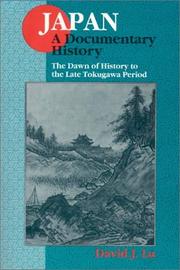| Listing 1 - 10 of 2197 | << page >> |
Sort by
|

ISBN: 0520919033 0585111847 9780520919037 9780585111841 0520081706 9780520081703 0520208773 9780520208773 Year: 1994 Publisher: Berkeley
Abstract | Keywords | Export | Availability | Bookmark
 Loading...
Loading...Choose an application
- Reference Manager
- EndNote
- RefWorks (Direct export to RefWorks)
How do ordinary people respond to prolonged terror? The convulsion of Japan's "Warring States" period between 1467 and 1568 destroyed the medieval order and exposed the framework of an early modern polity. Mary Elizabeth Berry investigates the experience of upheaval in Kyoto during this time. Using diaries and urban records (extensively quoted in the text), Berry explores the violence of war, misrule, private justice, outlawry, and popular uprising. She also examines the structures of order, old and new, that abated chaos and abetted social transformation. The wartime culture of Kyoto comes to life in a panoramic study that covers the rebellion of the Lotus sectarians, the organization of work and power in commoner neighborhoods, the replotting of urban geography, and the redefinition of authority and prestige in the arena of play.
Book
Year: 2019 Publisher: [Place of publication not identified] : Good Press,
Abstract | Keywords | Export | Availability | Bookmark
 Loading...
Loading...Choose an application
- Reference Manager
- EndNote
- RefWorks (Direct export to RefWorks)
Book
ISBN: 1135880530 1138997323 1135880468 1315060302 9781135880538 1306404843 9781306404846 Year: 2013 Publisher: London Routledge
Abstract | Keywords | Export | Availability | Bookmark
 Loading...
Loading...Choose an application
- Reference Manager
- EndNote
- RefWorks (Direct export to RefWorks)
These papers explore the debate over new directions in Japanese studies.
Periodical
ISSN: 18808077 Year: 1945 Publisher: Ōsaka-shi : Nihon Rinshi Gakkai,
Abstract | Keywords | Export | Availability | Bookmark
 Loading...
Loading...Choose an application
- Reference Manager
- EndNote
- RefWorks (Direct export to RefWorks)
Lepidoptera --- Insects --- Japan. --- Japan
Book
ISBN: 0429974604 0429494971 1785395262 0813346959 9780813346953 9780813346946 0813346940 Year: 2013 Publisher: Boulder, CO
Abstract | Keywords | Export | Availability | Bookmark
Periodical
Year: 2001 Publisher: Tokyo, Japan : Japan Medical Association,
Abstract | Keywords | Export | Availability | Bookmark

ISBN: 159995625X 0446562912 0446613428 Year: 2004 Publisher: New York, NY : Warner Books,
Abstract | Keywords | Export | Availability | Bookmark
 Loading...
Loading...Choose an application
- Reference Manager
- EndNote
- RefWorks (Direct export to RefWorks)
Immortalism --- Japan
Book
ISBN: 1282496271 9786612496271 0742557936 9780742557932 9780742541177 0742541177 Year: 2009 Publisher: Lanham, Md. Rowman & Littlefield
Abstract | Keywords | Export | Availability | Bookmark
 Loading...
Loading...Choose an application
- Reference Manager
- EndNote
- RefWorks (Direct export to RefWorks)
The emergence of Japan as a political and economic global power has been one of the most remarkable success stories of modern history. Though small in geographic area, the archipelago is the tenth most populous country, with 128 million inhabitants crowded into an area the size of Montana. Its natural resources are almost nonexistent, yet today it ranks only second after the much larger United States as the most affluent and economically productive nation in the world. Its rich cultural heritage and high-tech society are equally vibrant.For all readers wanting to better understand this dynamic country, this popular and accessible introduction offers an authoritative yet concise overview of two thousand years of Japanese history. Now fully updated to the present, this edition also includes an array of photographs and illustrations. The first half of the book explores the pre-Meiji era up to 1868. The second half traces domestic changes and relevant foreign issues in the modernizing era launched by the Meiji Restoration. Highlighting key historical events, Milton W. Meyer also includes cultural, artistic, and religious milestones. Summaries and datelines at the end of each chapter, as well as a glossary, offer additional essential reference points. With its clear explanations of Japanese traditions, religion, history, economics, politics, and relations with the West, this book provides an invaluable guide for understanding contemporary Japan.

ISBN: 1135937745 0429234023 1280179201 0203506677 9780203506677 9780415947527 0415947529 9786610179206 6610179204 0415947529 9781135937744 9781135937690 9781135937737 9780415653848 1135937737 Year: 2003 Publisher: New York Routledge
Abstract | Keywords | Export | Availability | Bookmark
 Loading...
Loading...Choose an application
- Reference Manager
- EndNote
- RefWorks (Direct export to RefWorks)
The main purpose of this book is to shed light on the limitations of the American hegemony in occupied Japan. Previous studies share the assumption that the United States was in a near-monopoly position to shape the postwar development in Japan as well as in the Asia-Pacific region. The book goes on to modify the prevailing view that American hegemony not only eroded under its own weight, but was never absolute in any case. Japan, a former enemy, eventually became America's main regional ally in the Asia-Pacific region.

ISBN: 1138179396 131570319X 1317467124 9781317467120 9781563249075 9781315703190 9781317467106 9781317467113 9781138179394 1563249073 Year: 2015 Publisher: London ; New York : Routledge,
Abstract | Keywords | Export | Availability | Bookmark
 Loading...
Loading...Choose an application
- Reference Manager
- EndNote
- RefWorks (Direct export to RefWorks)
An updated edition of David Lu's acclaimed ""Sources of Japanese History"", this two volume book presents in a student-friendly format original Japanese documents from Japan's mythological beginnings through 1995. Covering the full spectrum of political, economic, diplomatic as well as cultural and intellectual history, this classroom resource offers insight not only into the past but also into Japan's contemporary civilisation. This volume covers up to the late 18th century. Three major criteria used in the document selection were that: the selection avoids duplication with other collections
| Listing 1 - 10 of 2197 | << page >> |
Sort by
|

 Search
Search Feedback
Feedback About UniCat
About UniCat  Help
Help News
News